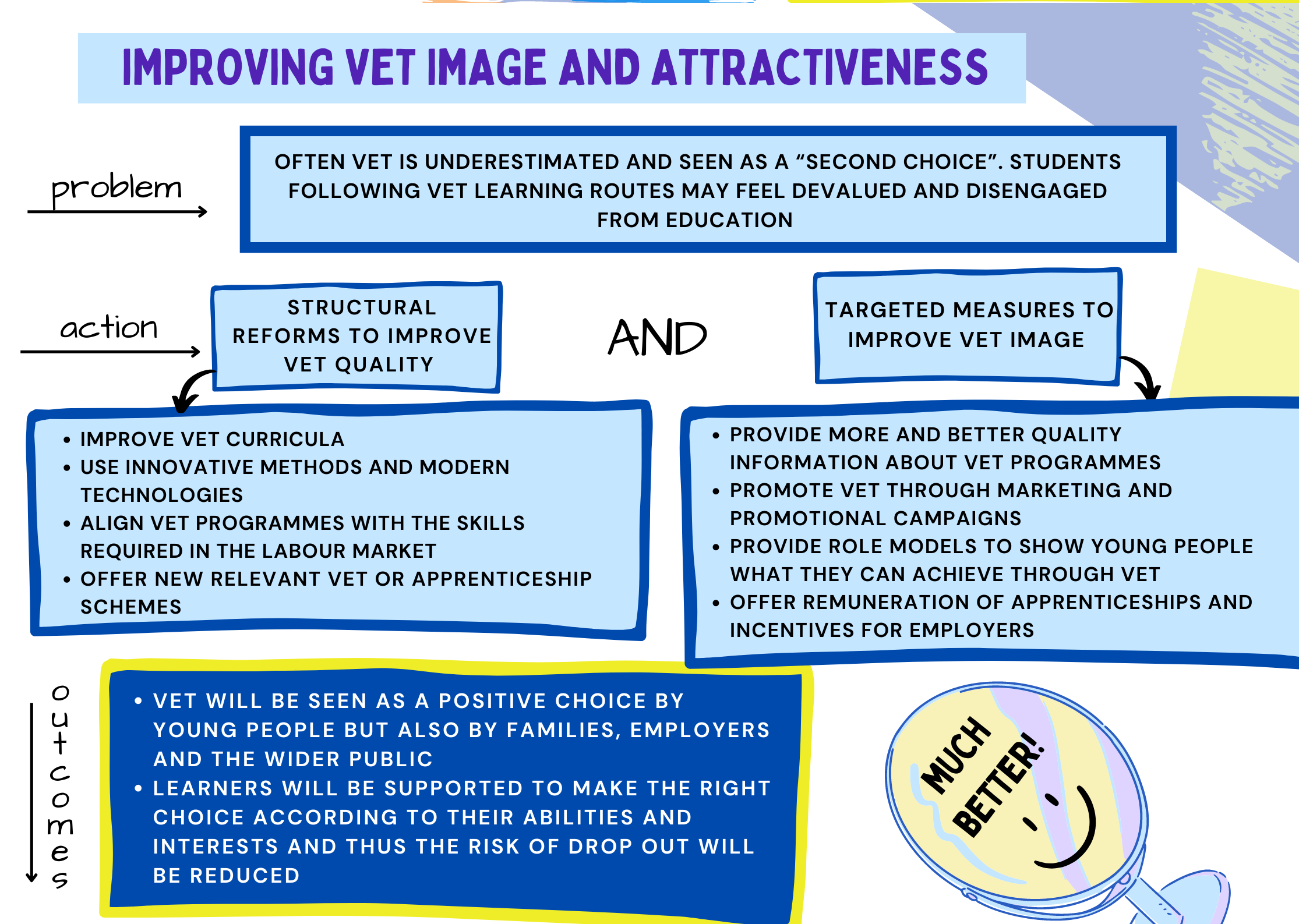Problem statement
Addressed problem: VET image and attractiveness
Vocational Education and Training (VET), both secondary and post-secondary, suffers from poor reputation. Additionally, the discourse on tertiary education still favours university education over post-secondary VET, which adds to its unattractiveness.
VET needs to be an appealing, credible alternative option to general routes, if it is to attract and retain the right learners. Its image needs to be improved not just in the eyes of young people, but also their families and other key players such as teachers, careers advisers and employers.
High quality VET can be an attractive option for young people. It offers a clear route to the labour market which for some is appealing. Some young people like the practical aspect of the learning process. Others may be interested in the opportunity to earn as they learn, or to work towards a specific profession.
Yet young people, their families and friends may have negative perceptions of VET, in comparison to general education pathways. This can lead young people to follow general routes which turn out not to be the best choice for them. The content or teaching style of these general courses may be a factor leading the young person to drop out. Low achievement, resulting from choosing a programme that does not match the young person’s abilities, can also be a reason for dropping out.
Negative perceptions of VET can lead young people following VET routes to have low self-esteem. If their parents, teachers and peers underestimate VET as a learning route, they may feel devalued. This can lead to disengagement from education. Young people who have enrolled in VET after leaving a general pathway are particularly affected. They see their VET education as a failure and find it hard to engage in it positively.

Beneficiaries
- Young people in an environment where VET has a poor image or is seen as a ‘second choice’.
- In some countries, young people from migrant backgrounds since their families may underestimate the value of VET in comparison to general education.
- Young people at risk of leaving a general pathway early due to poor performance.
- Young people in VET who have low self-esteem.
- Young people following VET routes which are less valued, respected and recognised.
- Labour market stakeholders where VET qualifications are less valued in comparison to general education.
Addressing the problem
How can the image of VET be improved?
There are many ways of improving the image of VET, which can go as far as structural reforms to improve the quality or relevance of VET. Reducing early leaving may not always be the main goal of these measures but is often anticipated as one of the results. For instance, perfecting VET curricula and delivering valuable degrees, using modern technologies and innovative learning methods and environments, aligning VET programmes with the skills required in the labour market, or offering new relevant VET or apprenticeship schemes.
Increasing quality is important, but is not enough on its own to change opinions and perceptions of VET. Here we focus on targeted measures to improve the image of VET; through information-provision, promotional activities, and role models. These activities aim to reach out to young people and their families, as well as school staff, employers and the wider public, to try to create a better ‘reputation’ for VET as a positive study choice, on a par with general education.
The following tips are given as advice to policy-makers and practitioners involved in the design and delivery of such measures. The information is based on Cedefop research into successful measures as well as other relevant evidence (see Further reading).
Providing accessible, user-friendly and impartial information on VET is important to ensure that young people can make informed choices. This information could cover, for example the content and level of the programmes, entry requirements, and the way in which they are delivered. Providing information about the quality and relevance of programmes to the labour market, e.g. labour market destinations, employability and income levels of former students, is also important. If VET is seen to lead fast to meaningful jobs, which are in demand on the labour market, it will be more attractive to young people.
Information provision should not just focus on young people. It is also important for parents, school staff, and employers to have access to appropriate information about VET options. Parents and school staff can then support young learners to make informed choices. Employers will have a better understanding of what graduates of VET programmes will be able to offer as potential employees.
Guidance and counselling is also vital to improve young people’s understanding of VET and to improve its image, both through paper, web-based and face-to-face formats.
Marketing and promotional campaigns can help raise awareness of VET and counter any negative associations it may have. The internet and social media can be a good way of engaging and involving young people in such campaigns, which could involve promoting success stories, for example.
Events such as annual ‘skills competitions’ may also help to raise the image of VET routes by celebrating the achievements of young people who study in VET. ‘VET weeks’ can present an opportunity to focus attention on VET as a study option. At a more local level, visits by learners in general tracks to VET schools and companies offering apprenticeships may help to raise awareness and understanding of VET options.
There is also a role for employers to play in promoting VET as a positive choice. Employers can show young people that VET routes can lead to career success, through participation in careers fairs for example, and developing their own promotional materials.
Role models are important to show young people the potential benefits of taking up a VET programme. VET ambassadors - current and former VET students who share their experience – can be a helpful way for young people to learn about VET options from their peers.
It is also important to create a positive image of the occupation that the training is leading to. Here there is a key part for the teachers/trainers to play. If a teacher/trainer is not proud of his or her professional identity, they might risk transferring this to the students. It is therefore important that the teachers and in-company trainers express that they are proud of their profession.
Remuneration can be a powerful motivator for a young person to pursue a VET programme. Some measures may offer financial support for learners who take part, to prevent their financial circumstances from being a barrier to participation and to increase motivation to take part. This may be particularly important for second chance measures. The financial support might be for example through allowances, grants, training ‘vouchers’ or a combined work/training measure in which the young person receives payment for the working part. Payment of grants / allowances may be linked to attendance.
In the case of apprenticeships, the company can provide a small wage to learners. For this to happen, it is important that the company sees the benefits of receiving learners and the contribution they can make to the business.
Public authorities can also provide financial incentives to companies. It is a long-standing tradition for some countries to offer a wage subsidy to employers who take on an apprentice. Such incentives can be particularly helpful for small businesses to be able to host apprenticeships. Also, incentives can be used to encourage employers to consider applicants they would not have considered otherwise, due to the additional time and support they may need.
Expected outcomes
Efforts to improve the image and attractiveness of VET aim to change young people’s perceptions, as well as parents’, school staff, employers’ and the wider public. By creating a better understanding of VET as a positive choice, rather than a ‘second choice’, learners can be supported to make the right choice according to their abilities and interests, thus helping to reduce the risk of drop-out. Those already in VET may have increased self-esteem and motivation, thereby reducing the risk that they leave early.
Policy efforts to promote excellence in VET are also extremely important. Awareness-raising and promotion to improve the image of VET cannot succeed if, in reality, the quality of provision is low. It is important to ensure that the educational offer meets the needs of both learners and employers. VET must have a clear and positive link to the labour market. If this is not the case, then efforts to improve its image will have little effect.
The following outcomes can be expected at different levels:
| INDIVIDUAL | INSTITUTIONAL | SYSTEM |
|
|
|




